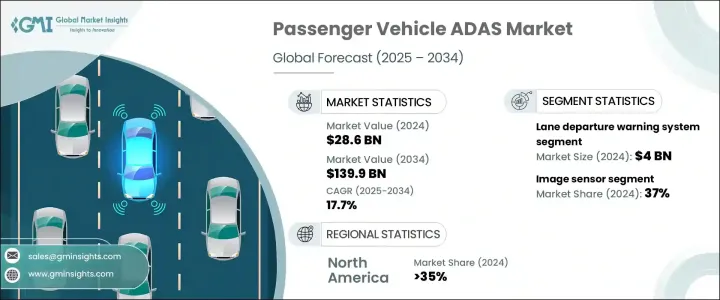
세계 승용차 ADAS 시장은 2024년 286억 달러 규모로 평가되었고, 2025년부터 2034년까지 연평균 17.7% 성장할 것으로 예측됩니다.
ADAS가 제공하는 편의성과 높은 기능성과 더불어 자동차 안전에 대한 소비자의 관심이 높아지면서 ADAS에 대한 수요가 증가하고 있습니다. 자동차 제조업체들은 진화하는 소비자 선호도와 전 세계적으로 강화되는 안전 규제에 대응하기 위해 ADAS를 적극적으로 모델에 적용하고 있습니다. 각국 정부는 더욱 엄격한 안전 기준을 시행하고 있으며, 자동차 제조업체들은 자동차 안전 기준을 강화해야 하는 상황에 직면해 있습니다. 운전 보조 기술이 탑재된 차량을 선택하는 소비자가 증가하고 있으며, 시장은 빠르게 성장하고 있습니다. 또한, 도시화의 진전과 교통 혼잡 증가는 보다 안전하고 효율적인 운전에 기여하는 이러한 시스템의 채택을 촉진하고 있으며, AI 기반 비전 시스템 및 실시간 데이터 처리와 같은 기술 발전은 이 분야를 더욱 혁신적으로 변화시켜 다양한 차량 부문에서 ADAS를 보다 쉽게 사용할 수 있도록 하고 있습니다. 다양한 차량 부문에서 ADAS를 보다 쉽게 이용할 수 있도록 하고 있습니다. 그 결과, 고급차와 중급차 모두 ADAS 통합이 급증하고 있으며, 모빌리티의 미래를 형성하고 전 세계적으로 교통 안전을 강화하고 있습니다.

시장은 시스템 유형별로 구분되며, 특히 적응형 크루즈 컨트롤, 차선 이탈 경보, 자동 긴급 제동, 전방 충돌 경보 등이 주목받고 있으며, 2024년에는 차선 이탈 경보 시스템의 점유율이 15%를 차지하여 40억 달러에 달했습니다. 이 시스템은 의도하지 않은 차선 이탈을 감지하여 즉시 경고를 발령하거나 조향 조작을 수정하는 등 사고 예방에 중요한 역할을 합니다. 교통 안전이 최우선 과제인 만큼 차선 이탈 경고 기능이 탑재된 자동차를 찾는 소비자가 증가하고 있으며, 이는 이 시스템의 보급 확대에 기여하고 있습니다. 자동차 제조업체들은 이러한 기술을 지속적으로 개선하여 보다 정확한 실시간 운전 상황에 대응할 수 있도록 하고 있습니다.
| 시장 범위 | |
|---|---|
| 시작 연도 | 2024년 |
| 예측 연도 | 2025-2034년 |
| 시작 금액 | 286억 달러 |
| 예상 금액 | 1,399억 달러 |
| CAGR | 17.7% |
센서 기술 측면에서 시장은 레이더, 라이더, 이미지 센서, 기타로 나뉩니다. 이미지 센서 분야는 2024년 37%의 점유율을 차지하며 ADAS 기능의 주요 구성 요소임이 입증되었습니다. 이러한 시스템에 내장된 고해상도 카메라는 필수적인 시각 데이터를 제공하여 장애물, 도로 표지판, 보행자를 정확하게 감지할 수 있게 해줍니다. 레이더 및 초음파 센서와 달리 이미지 센서는 뛰어난 시각적 디테일을 제공하여 ADAS 기능의 정확성과 신뢰성을 향상시킵니다. 또한 다양한 조명 조건과 기상 조건에서 효과적으로 작동하기 때문에 교통 안전에 대한 기여도가 더욱 높아집니다. 자동차 제조업체들이 운전 보조 기술의 정확성과 반응성을 우선시함에 따라 이미지 센서에 대한 수요는 증가할 것으로 예측됩니다.
미국 승용차 첨단운전자보조시스템(ADAS) 시장은 2024년 76억 달러 규모로 성장했으며, 이는 안전 기능 강화에 대한 소비자 수요 증가와 첨단운전자보조시스템에 대한 규제 강화에 힘입은 것으로 분석됩니다. 교통 안전에 대한 우려와 자율주행 솔루션에 대한 필요성이 높아지면서 자동차 구매자들은 차선 유지 보조, 자동 긴급 제동, 어댑티브 크루즈 컨트롤 등이 장착된 차량을 선호하고 있습니다. 미국 자동차 제조업체들은 다양한 차종에 ADAS 기능을 표준 또는 옵션으로 장착하여 대응하고 있습니다. 기술 혁신이 이러한 시스템을 계속 발전시켜 나감에 따라 미국 시장은 세계 ADAS 시장의 주요 기업로 남을 것으로 보입니다.
The Global Passenger Vehicle ADAS Market was valued at USD 28.6 billion in 2024 and is projected to grow at a CAGR of 17.7% between 2025 and 2034. The increasing consumer emphasis on vehicle safety, coupled with the convenience and advanced functionalities offered by ADAS, is fueling demand for these technologies. Automakers are actively integrating ADAS into their models to cater to evolving consumer preferences and stringent safety regulations worldwide. Governments across various regions are enforcing stricter safety norms, compelling manufacturers to enhance vehicle safety standards. With a growing number of consumers opting for vehicles equipped with driver assistance technologies, the market is witnessing rapid expansion. Additionally, the rise in urbanization and increasing traffic congestion is pushing the adoption of these systems, as they contribute to safer and more efficient driving. Technological advancements, such as AI-powered vision systems and real-time data processing, are further revolutionizing the sector, making ADAS more accessible across different vehicle segments. As a result, luxury and mid-range vehicles alike are seeing a surge in ADAS integration, shaping the future of mobility and enhancing road safety on a global scale.

The market is segmented based on system types, with the most notable being adaptive cruise control, lane departure warning, automatic emergency braking, and forward collision warning, among others. In 2024, the lane departure warning system accounted for a 15% share, valued at USD 4 billion. This system plays a critical role in accident prevention by detecting unintentional lane departures and issuing immediate alerts or corrective steering actions. As road safety remains a priority, more consumers are seeking vehicles equipped with lane departure warnings, contributing to the system's increasing adoption. Automakers continue to refine these technologies, making them more accurate and responsive to real-time driving conditions.
| Market Scope | |
|---|---|
| Start Year | 2024 |
| Forecast Year | 2025-2034 |
| Start Value | $28.6 Billion |
| Forecast Value | $139.9 Billion |
| CAGR | 17.7% |
In terms of sensor technology, the market is divided into radar, lidar, image sensors, and others. The image sensor segment held a 37% share in 2024, proving to be a key component of ADAS functionalities. High-resolution cameras embedded within these systems provide essential visual data, enabling precise detection of obstacles, road signs, and pedestrians. Unlike radar or ultrasound sensors, image sensors offer superior visual detail, improving the accuracy and reliability of ADAS features. Their ability to function effectively in diverse lighting and weather conditions further enhances their contribution to road safety. As automakers prioritize precision and responsiveness in driver-assistance technologies, the demand for image sensors is set to rise.
U.S. passenger vehicle ADAS market generated USD 7.6 billion in 2024, driven by increasing consumer demand for enhanced safety features and a growing regulatory push for advanced driver assistance systems. Rising concerns over road safety and the need for automated driving solutions are prompting car buyers to favor vehicles equipped with lane-keeping assist, automatic emergency braking, and adaptive cruise control. Automakers in the U.S. are responding by making ADAS features standard or optional across various vehicle models. As technological innovations continue to refine these systems, the U.S. market is set to remain a major player in the global ADAS landscape.